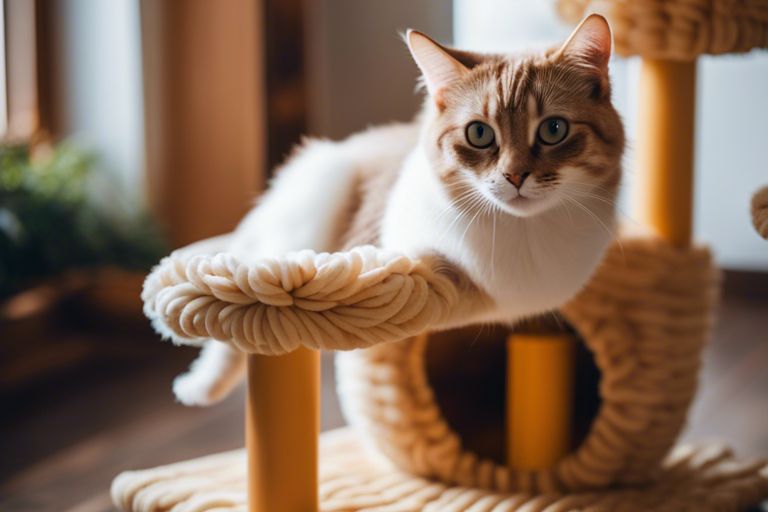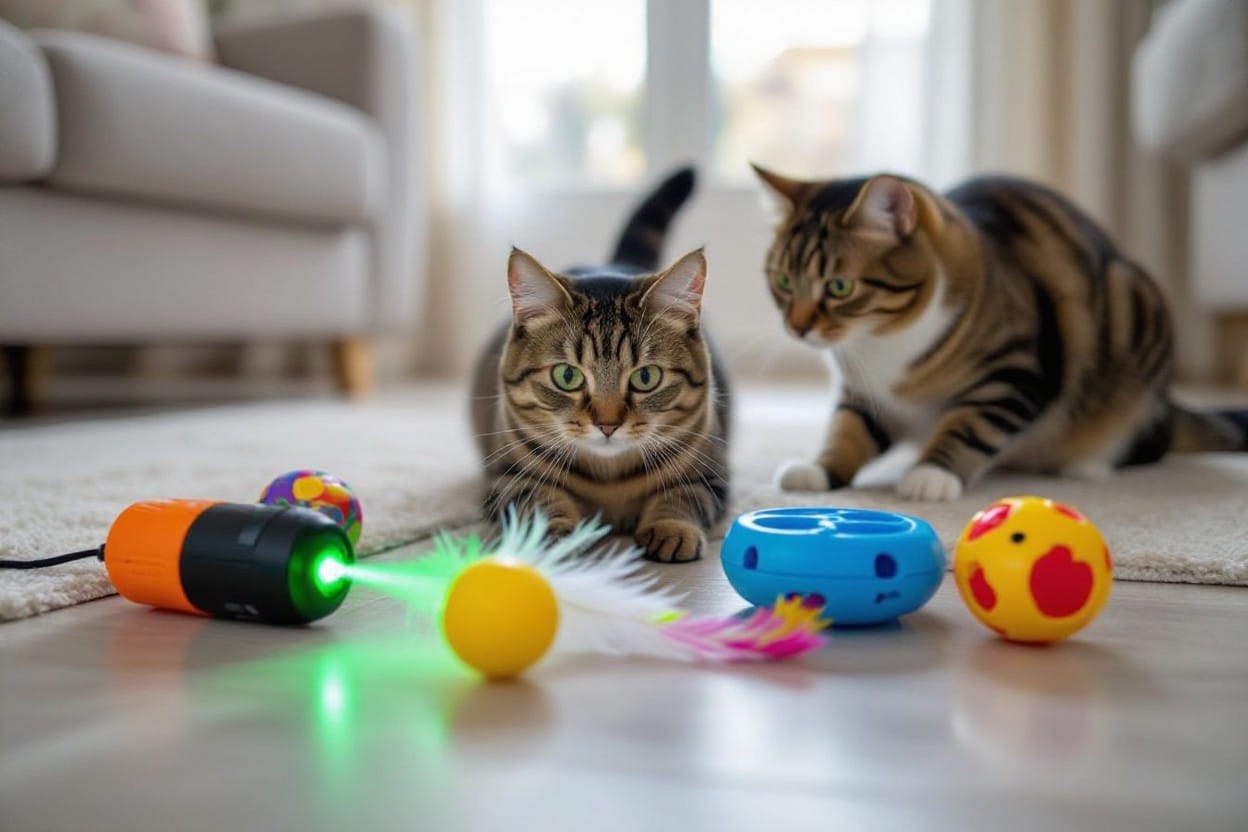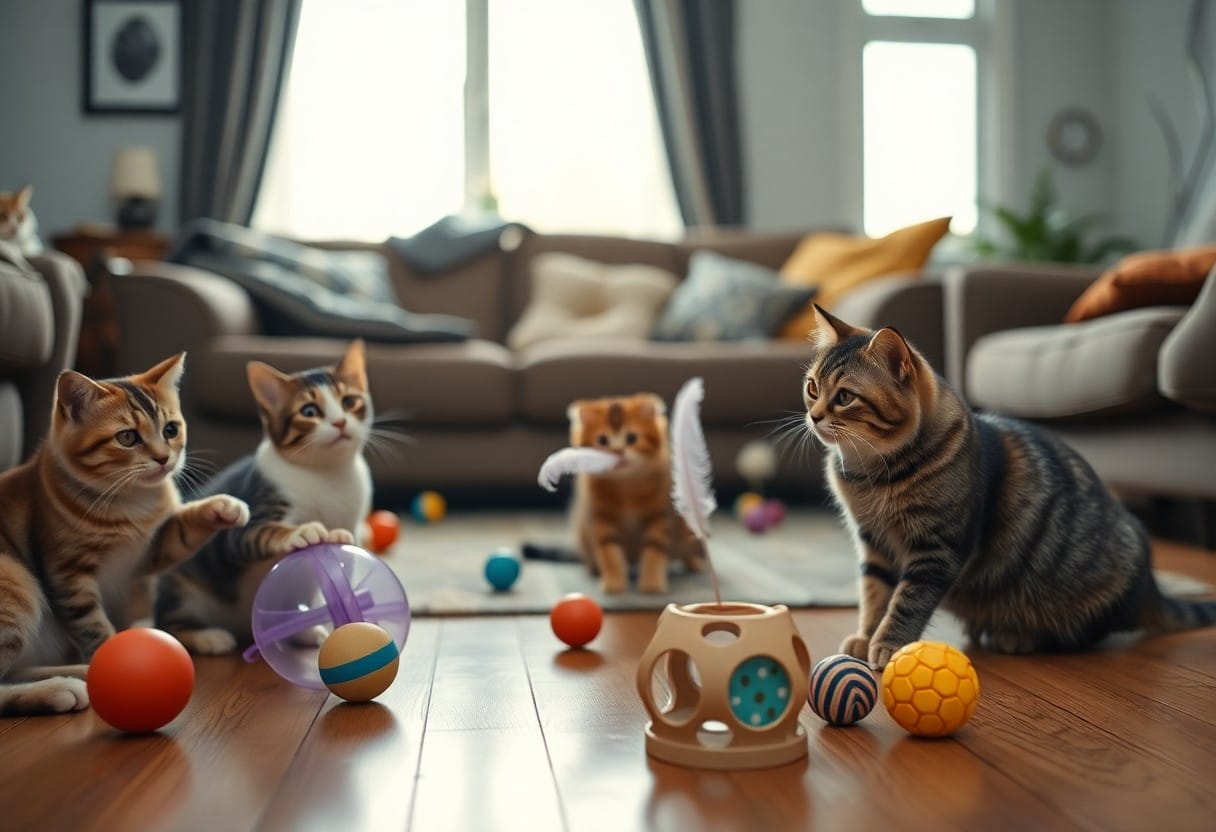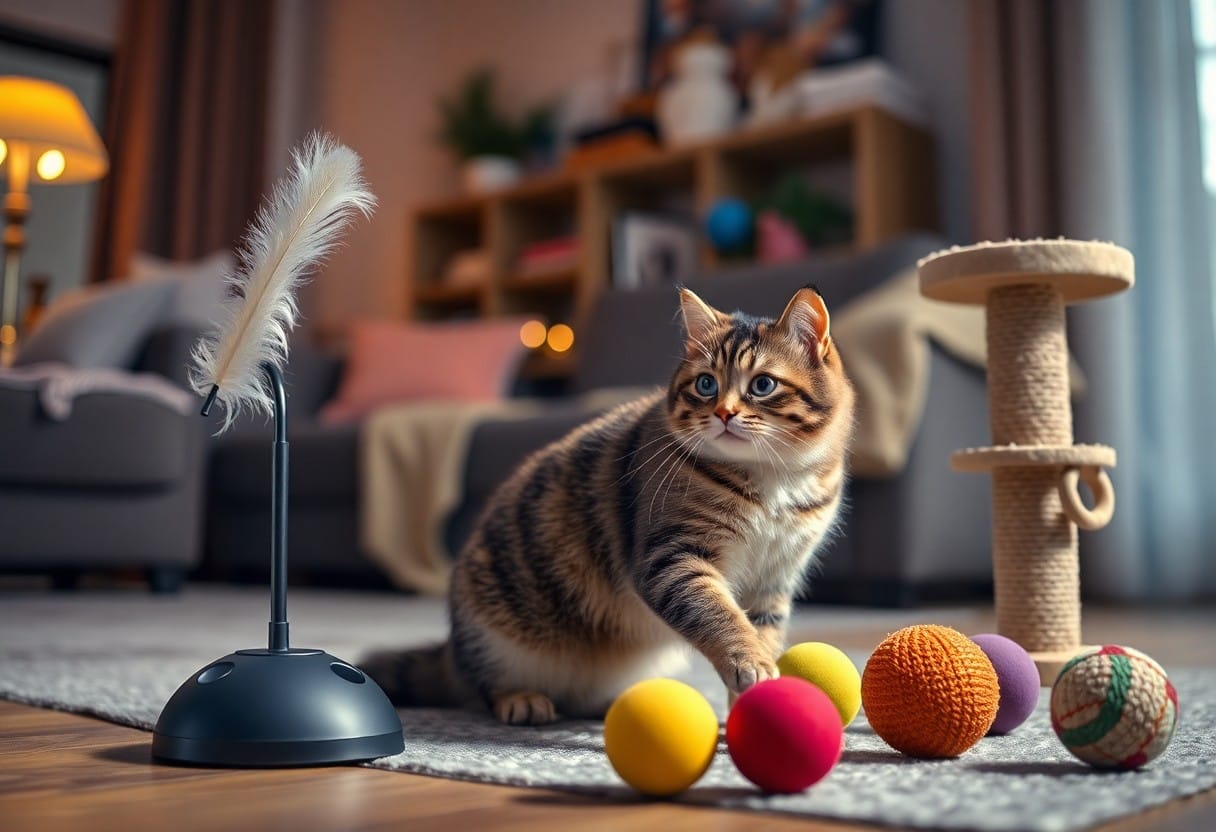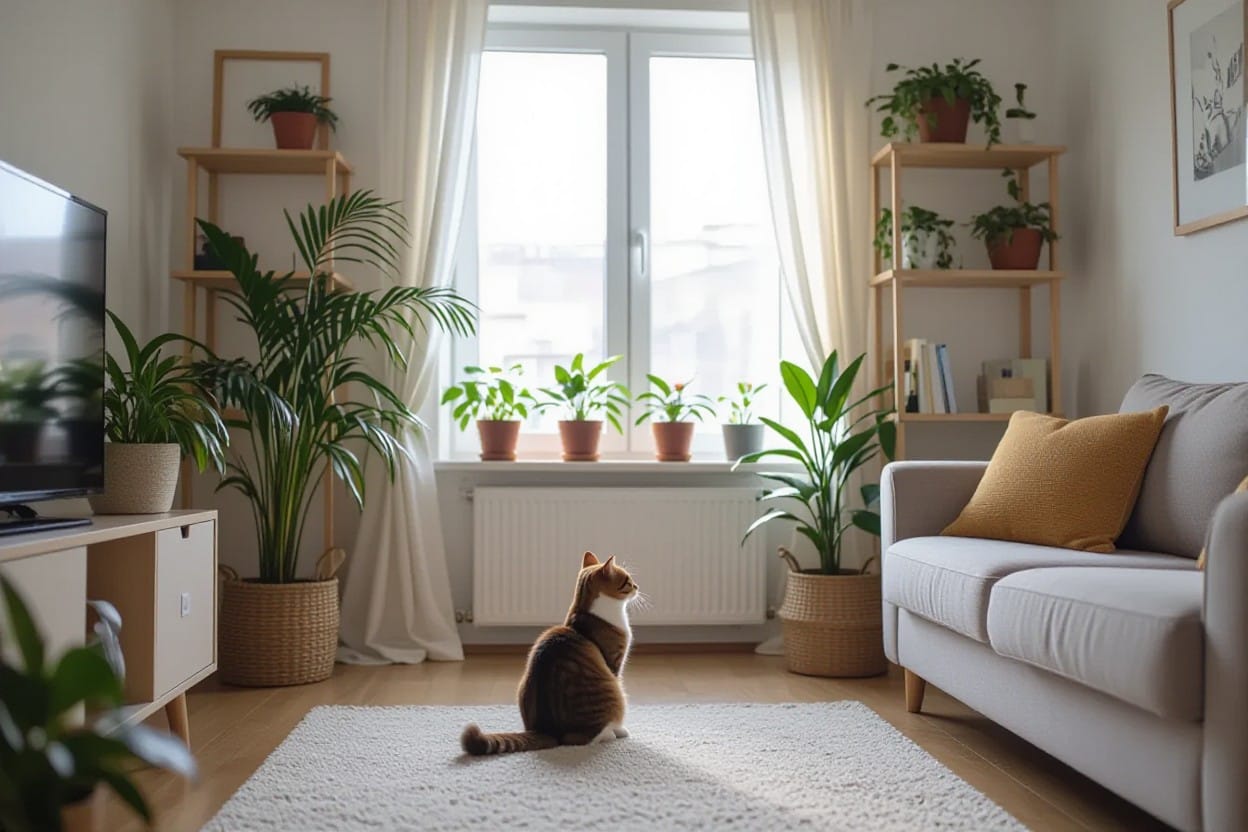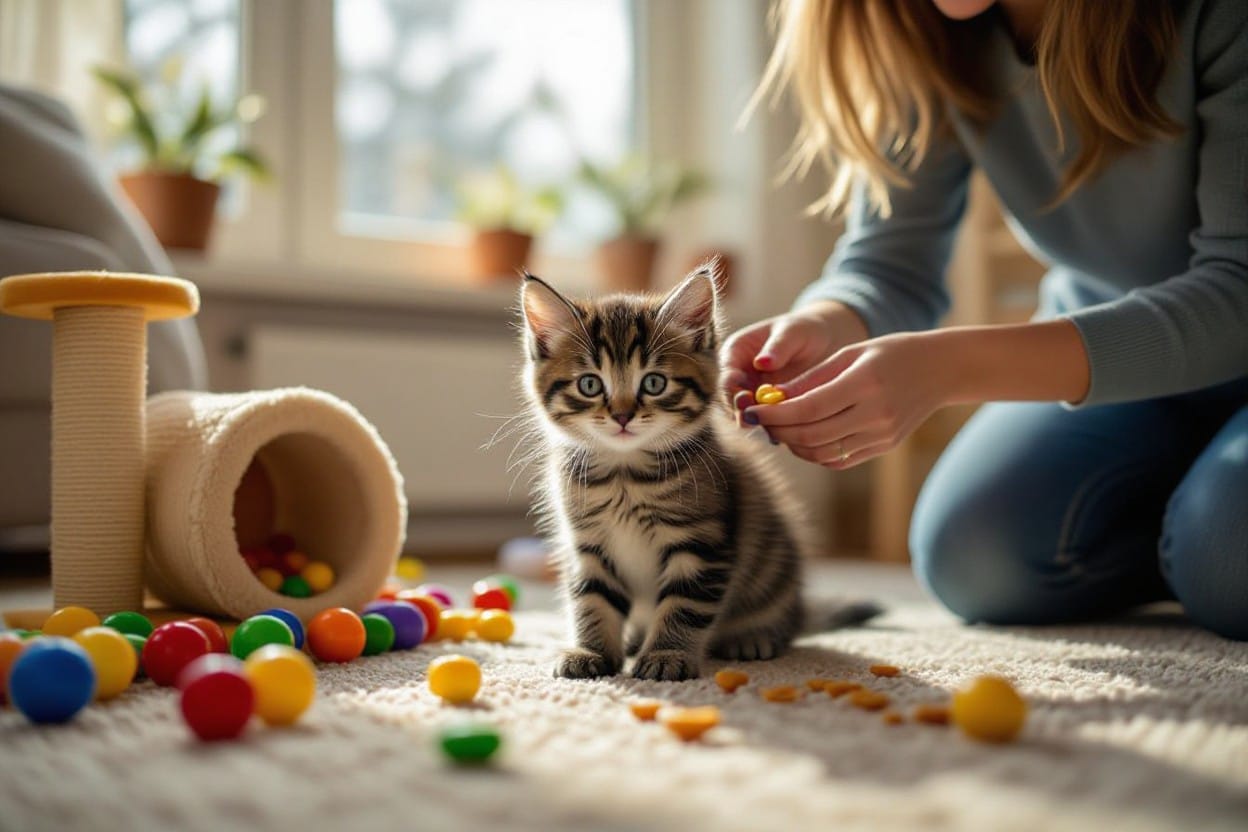Over 60% of domestic cats in the United States are kept indoors for their safety. As responsible pet owners, it is crucial to provide our feline companions with a stimulating and secure environment to meet their physical and mental needs. By implementing key strategies such as vertical space, interactive toys, scratching posts, and safe plants, you can ensure that your indoor cat leads a happy and fulfilling life while also preventing potential health and behavioral issues.
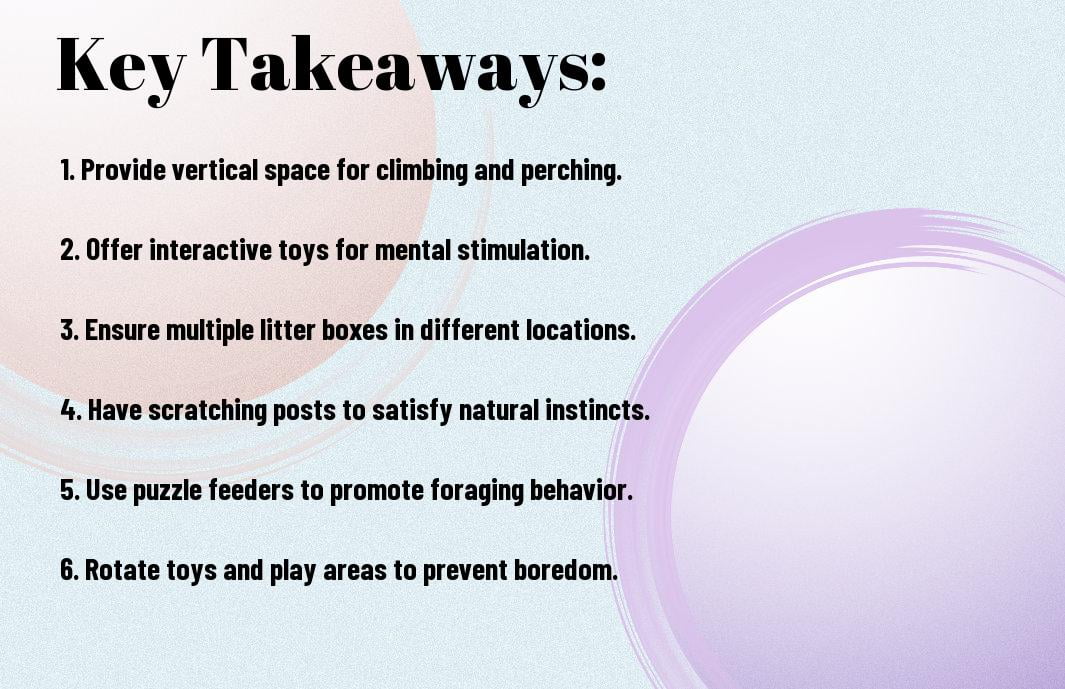
Understanding Your Indoor Cat’s Needs
You share your home with your indoor cat, and it’s necessary to understand their needs to provide them with a safe and enriching environment. By understanding what your cat requires, you can ensure they have a fulfilled and happy life indoors.
Psychological needs: Play and stimulation
Understanding your indoor cat’s psychological needs is crucial for their overall well-being. Cats are natural hunters and need mental and physical stimulation to thrive. Providing interactive toys, scratching posts, and engaging with your cat through playtime can help satisfy their hunting instincts and keep them mentally sharp. Create a stimulating environment with hiding spots, climbing structures, and puzzle feeders to keep your indoor cat active and engaged.
Physical needs: Diet and exercise
On top of meeting their psychological needs, indoor cats also have physical needs that require attention. A balanced diet is necessary for maintaining your cat’s health and weight. Consult with your veterinarian to ensure you are feeding your cat the right type and amount of food. Regular exercise is equally important for indoor cats to prevent obesity and boredom. Interactive toys, laser pointers, and even leash training for supervised outdoor walks can help your cat stay active.
The key to meeting your indoor cat’s physical needs is to provide a healthy diet and opportunities for regular exercise. Feeding your cat quality cat food that is appropriate for their age and health status is crucial. Additionally, engaging your cat in play sessions and providing climbing structures or cat trees can help them stay active and maintain a healthy weight.
The Safe Zone: Creating A Hazard-Free Home
Identifying and eliminating common household hazards
Assuming the role of a pet parent to an indoor cat comes with the responsibility of creating a safe environment free of potential hazards. Any cat owner should be aware of common household items that can pose a threat to their cat’s well-being. These include toxic plants, electrical cords, small objects that can be swallowed, open windows, and precarious furniture that can topple over.
The role of cat-proofing in safety
With the proper cat-proofing measures in place, you can significantly reduce the risk of accidents and injuries to your feline friend. catproofing involves securing toxic plants out of reach, using cable protectors for electrical cords, keeping small objects stored away, installing sturdy screens on windows, and anchoring furniture to prevent tipping. By implementing these precautions, you can create a secure and enriching environment for your indoor cat.
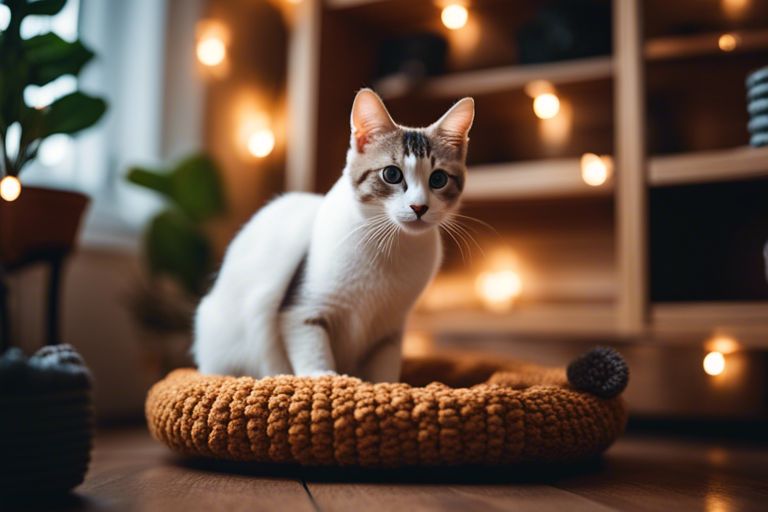
Enrichment Essentials: Toys And Play
Choosing the right toys for your cat
Enrichment through play is necessary for ensuring your indoor cat stays happy and healthy. When dicking out toys for your feline friend, consider their preferences and instincts. Cats are natural hunters, so toys that simulate hunting behaviors, such as toys with feathers or small moving objects, are often a big hit. Interactive toys that engage your cat’s senses and encourage physical activity are also a great choice. Rotating your cat’s toys regularly can prevent boredom and keep them stimulated.
Strengthening the bond with your cat
Interactive play sessions are not only a fun way to keep your cat entertained but also a valuable opportunity to strengthen your bond with them. Use interactive toys like dangling strings or laser pointers to engage your cat in play. These activities mimic hunting and prey behaviors, allowing your cat to unleash their natural instincts. Spending quality time playing with your cat can help build trust and deepen your relationship, ultimately leading to a happier and more content kitty.
Aim for at least 10-15 minutes of interactive playtime with your cat each day. This dedicated time will not only provide physical and mental stimulation for your feline companion but also foster a strong and lasting connection between you both.
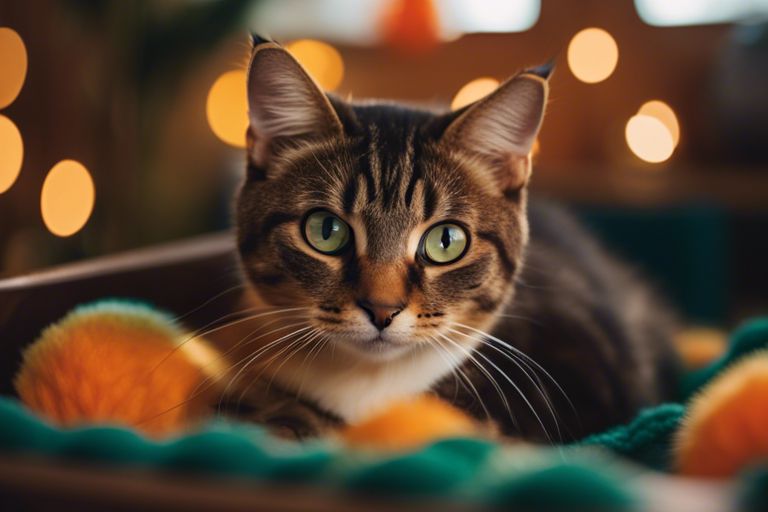
Climbing And Exploration: Vertical Space
The importance of vertical space for indoor cats
Exploration is a crucial aspect of an indoor cat’s well-being. Cats are natural climbers and jumpers, and having access to vertical space allows them to feel safe and secure while also satisfying their instinctual need to explore their surroundings from a higher vantage point. Vertical space provides enrichment and mental stimulation for your cat, preventing boredom and potential behavior issues that can arise from a lack of stimulation.
How to incorporate vertical space in your home
Vertical space can be easily incorporated into your home to create a safe and enriching environment for your indoor cat. Providing cat trees, shelves, perches, and climbing towers are great ways to maximize the use of vertical space. These structures can be placed near windows to allow your cat to watch the outside world, or in areas where they can observe the household activity from above. Be sure to secure the structures properly to ensure your cat’s safety while they explore and climb.
It’s important to offer a variety of vertical options at different heights and levels, as cats enjoy having choices and may prefer certain spots for different activities such as napping, bird watching, or simply lounging and relaxing.
Relaxation And Privacy: Establishing Cozy Hideaways
The need for private spaces
Cozy hideaways are necessary for indoor cats to feel safe, relaxed, and in control of their environment. Cats are naturally territorial animals and having a private space where they can retreat to when feeling overwhelmed or stressed is crucial for their well-being. These hideaways provide a sense of security and allow your cat to have some much-needed alone time.
Tips for creating safe and appealing hideaways
On top of providing a cozy bed or blanket-lined nook, consider incorporating vertical spaces like cat trees or shelves for your cat to perch on and observe their surroundings. Cats also love enclosed spaces, so a covered pet bed or a cardboard box with a soft blanket inside can make the perfect hideaway. To make these spots even more enticing, try adding some catnip or a favorite toy to encourage your cat to explore and use them regularly.
- Make sure the hideaway is placed in a quiet and low-traffic area of your home to give your cat the privacy they need.
- Provide multiple hideaway options around the house to cater to your cat’s different moods and preferences.
- Recognizing when your cat is seeking solitude and giving them space is key to building trust and strengthening your bond.
Understanding your indoor cat’s need for relaxation and privacy is vital for creating a harmonious living environment. By offering cozy hideaways that cater to their natural instincts, you can help your feline companion feel secure and content in your home.
- Be observant of your cat’s body language and behavior to identify when they are in need of some quiet time.
- Recognizing and respecting your cat’s boundaries will help them feel more comfortable and happy in their indoor environment.
Nutritional Considerations For Indoor Cats
Understanding the dietary needs of indoor cats
Your indoor cat has unique dietary needs compared to outdoor cats. Since they are not as active, it’s important to provide them with a diet that supports their lower energy levels. Indoor cats require a balanced diet that is rich in protein, vitamins, and minerals to maintain their overall health and wellbeing. Look for cat food specifically formulated for indoor cats to ensure they are getting the right nutrients.
Keeping your indoor cat at a healthy weight
Cats have a tendency to gain weight if they are not provided with the right diet and exercise. Indoor cats, in particular, are at a higher risk of becoming overweight due to their sedentary lifestyle. Monitoring your cat’s weight and feeding them appropriate portion sizes is crucial to keeping them healthy. Consult with your veterinarian to determine the right amount of food for your indoor cat based on their age, weight, and activity level.
Being overweight can lead to various health problems in cats, including diabetes, joint issues, and heart disease. Regular play sessions and providing interactive toys can help keep your indoor cat active and prevent weight gain. Additionally, avoid free feeding and opt for scheduled meal times to control your cat’s food intake.
Behavioral Health And Wellness
Recognizing signs of stress or boredom in your cat
Boredom in indoor cats can lead to undesirable behaviors such as excessive meowing, scratching furniture, or even aggression. Signs of stress in your cat may include hiding, decreased appetite, or increased vocalization. It’s important to recognize these signs early on to address any potential issues and provide a stimulating environment for your feline friend.
Solutions for common behavioral issues
Your indoor cat may benefit from interactive toys, puzzle feeders, or even a cat tree to provide climbing opportunities and perches. These enrichment activities can help alleviate boredom and encourage natural behaviors. In some cases, consulting with a veterinarian or animal behaviorist can also provide tailored solutions to address specific behavioral issues your cat may be experiencing.
Conclusion
Ultimately, creating a safe and enriching environment for your indoor cat is vital for their overall well-being and happiness. By implementing these strategies such as providing vertical space, interactive toys, scratching posts, and hiding spots, you can help satisfy your cat’s natural instincts and keep them mentally and physically stimulated. Additionally, ensuring their environment is secure, free of hazards, and enriched with regular playtime and affection will help prevent behavior issues and promote a healthy lifestyle for your feline companion.
Recall, every cat is unique, so it may take some trial and error to find the perfect combination of enrichment activities that suit your cat’s preferences. By prioritizing their safety, health, and happiness, you can create a harmonious indoor environment that allows your cat to thrive and live their best life.
FAQ
Q: Why is it important to create a safe and enriching environment for your indoor cat?
A: Creating a safe and enriching environment is important for your indoor cat’s physical and mental well-being. It helps prevent boredom, obesity, and behavioral issues while ensuring your cat feels secure and comfortable in its surroundings.
Q: How can I ensure my indoor cat gets enough exercise?
A: To ensure your indoor cat gets enough exercise, provide interactive toys, scratching posts, cat trees, and opportunities for play. You can also engage your cat in regular play sessions to keep them active and mentally stimulated.
Q: What are some ways to create a safe environment for my indoor cat?
A: To create a safe environment for your indoor cat, ensure all windows and balconies are secure, remove toxic plants and household items, keep electrical cords out of reach, and carefully choose and monitor any other pets in the household.
Q: How can I enrich my indoor cat’s environment?
A: Enrich your indoor cat’s environment by providing hiding spots, elevated perches, puzzle feeders, interactive toys, and scratching surfaces. You can also create cozy resting areas and rotate toys to keep things interesting for your cat.
Q: What are some signs that my indoor cat is not thriving in its environment?
A: Signs that your indoor cat is not thriving in its environment include increased aggression, excessive grooming, hiding, overeating, or urinating outside the litter box. If you notice any of these behaviors, it’s crucial to reassess your cat’s environment and make necessary changes.
